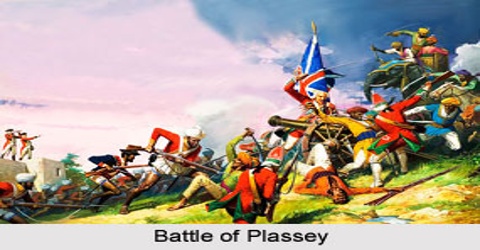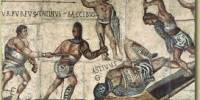Major purpose of this assignment is to briefly discuss on The war of Polashi. The battle of Palashi, was fought between Nawab SIRAJUDDAULA as well as the EAST INDIA COMPANY on 23 June 1757. It lasted for about eight hours as well as the Nawab was defeated by the company due to treachery of his foremost general MIR JAFAR. Mir Jafar was aspiring to the throne, his local associates wanted more income, power and privileges, and the East India Company was ready for unlimited concessions for your lucrative trade in Bengal.
Introduction
The battle of Palashi, was fought between Nawab sirajuddaula and the east india company on 23 June 1757. It lasted for about eight hours and the Nawab was defeated by the company because of the treachery of his leading general mir jafar. Palashi’s political consequences were far-reaching and devastating and hence, though a mere skirmish, it has been magnified into a battle. It laid the foundation of the British rule in Bengal. For the English East India Company, Bengal was the springboard from which the British expanded their territorial domain and subsequently built up the empire, which gradually engulfed most parts of India and ultimately many parts of Asia as well.
The Background:
The battle had a long background that could be traced from the beginning of the East India Company’s settlement in Bengal in early 1650s. The Mughal rulers of Bengal allowed the East India Company to settle in Bengal and trade free of duty on payment of an annual sum of three thousand taka. Within a few years of their settlement at hughli and kasimbazar the company’s trade began to expand rapidly both physically and in terms of capital investment. But their intrusion into the internal trade of Bengal became a cause of conflict between shaista khan, the Mughal subahdar, and the English in the last quarter of the 17th century. After Shaista Khan had left Bengal the English were allowed to settle in Calcutta, purchase the zamindari rights over the three villages of Kalikata, Govindapur and Sutanuti. They established a fort at Calcutta and named it fort william.
The purchase of zamindari and the establishment of the Fort William proved highly profitable to the East India Company and the vested interest that was created in it led them to purchase more zamindari lands (38 villages) around Calcutta. Meanwhile the abuse of trade privileges progressively worsened their relations with the Bengal nawabs. The company’s authority at Calcutta hardly paid any attention to the directives of the court of directors from London to stop this evil practice and the privileges of dastak was illegally extended from the import-export trade to cover also the internal trade. At the same time the servants of the company began to use the trade permit to cover their private trade.
The company in its attempt to secure more privileges approached the Mughal Emperor farrukh siyar, who by a farman (1717) granted it important privileges which included duty-free trade, establishment of a mint at Calcutta and right to purchase 38 villages on certain conditions. As other merchants had to pay duty at certain rates while the English and their partners traded duty-free, the local merchants were threatened to be eliminated from the internal trade. Nawab murshid quli khan obstructed the implementation of the farman as he realised that in spite of the growing import-export trade of the company, it would escape with the annual payment of a meagre three thousand taka and the privileges would also deprive the government of its legitimate revenues from the internal trade as well as from the mint duties.
With the accession of Sirajuddaula in April 1756, the conflict between the nawab and the English company became almost inevitable as the young nawab, for the first time, protested vehemently against the unlawful activities of the company in Bengal. He had three main grievances against the British-the unauthorized fortifications of Fort William, illegal private trade and shameless abuse of dastaks by the company servants, and illegal shelter given to the nawab’s erring subjects. The nawab asked the British to take measures to remove his grievances and sent several diplomatic missions to Calcutta for amicable settlement of the dispute. The nawab demanded the extradition of Krishna Das and asked the English to demolish the new fortifications and ordered to fill up the ditch, which surrounded the Calcutta Settlement. The English insulted nawab’s special envoy, who carried his letter to Calcutta. When Narayan Sing reported how unceremoniously Roger drake, the English governor of Calcutta, had dismissed him, nawab’s temper was inflamed. Drake is reported to have said, “the sooner he [the nawab] came to Calcutta the better and he [Drake] would make another nawab”
The nawab immediately ordered his forces to surround the Kasimbazar factory. The factory chief surrendered but the company’s governor at Calcutta became obstinate. There upon, the nawab marched upon Calcutta and captured it. The reestablishment of the company in Bengal after their defeat was possible in one of the two ways either surrendering to the nawab or to apply force to avenge the defeat. The British in Bengal appealed for urgent reinforcements to Fort St. George (Madras) which decided to send an expeditionary force under Robert clive and Admiral charles watson to Bengal. They recovered Calcutta in January 1757 and declared a manifesto of war against the nawab. At this Nawab Sirajuddaula was compelled to sign the alinagar treaty with the English.
The Conspiracy:
The tension of war continued as the English, disregarding the treaty, started hatching up a conspiracy with the disaffected courtiers of the nawab. There is no denial that a section of the influential members of the nawab’s court at murshidabad, who were dissatisfied with Sirajuddaula, was trying to hatch a conspiracy to oust the nawab. But the point to emphasise is that without the active involvement of the British, there would have been in all probability no Palashi ‘revolution’. It was the British who were more anxious than the other conspirators to put their own scheme of overthrowing the nawab. The company servants and other merchant adventurers closely connected with the British trade in India – though not so much the Company Directors in London – did from time to time advocate, in no uncertain terms, the acquisition of territories in India. The private trades of the company servants was facing a severe crisis in the mid-18th century and in order to retrieve their private trade fortunes, they took recourse to ‘sub-imperialism’.
In fact, the seeds of the Palashi conspiracy were sown in the ‘Instructions’ of the Fort George Council (13 October 1756) which recommended ‘not mere retaking of Calcutta’ and ‘ample reparations’, but urged ‘to effect a junction with any powers in the province of Bengal that might be dissatisfied with the violence of the Nawab’s government or that might have pretensions to the Nawabship’. The implication of the last portion of the recommendation is too obvious to be emphasised. Even Clive wrote before sailing from Madras that Sirajuddaula was a weak prince and that most of his courtiers were dissatisfied. It was on this resentment at the court of the nawab that the British played ‘the nice important game’, as Clive reflected later on, and precipitated the conspiracy leading to the Palashi coup.
Both Clive and Orme (who was the official historian of the English East India Company and was in Bengal in the early 1750s) were aware of Colonel Scott’s plan, prepared in Calcutta in 1752, of the conquest of Bengal, which was then with the Fort George Council. Clive was greatly impressed by the wealth of Bengal on an earlier visit to Calcutta in the winter of 1749-50. The British private trade was facing a severe crisis in the late 1740s and early 1750s because of the sudden spurt in the French private trade and Asian maritime trade under the Armenian merchant Khwaja Wajid as is borne out by the shipping lists in the Dutch records. So the destruction of the French, which would prevent a Franco-Bengali alliance, and the deposition of the nawab who was threatening to stop the illegal private trade and misuse of dastaks – both essential for rescuing the battered private trade fortunes of the British – became the main target of the company servants’ sub-imperialism.
Despite the assertion of several historians that it was the Indian conspirators who got in touch with the British for cooperation in the proposed ‘revolution’, there can hardly be any doubt from a careful reading of the documents that it was the British who contacted the disgruntled elements in the court for their support in the British plan of the coup. On 9 April 1757, Luke Scrafton wrote from Kasimbazar to Clive’s confidant, John Walsh, ‘For God’s sake let us proceed on some fixed plan85. How glorious it would be for the Company to have a Nawab devoted to them!’ He wrote to Walsh again on April 18 about the plan of setting up Yar Latif Khan as the new nawab. Meanwhile the Select Committee adopted on April 23 the coup d’etat as its official policy. On that very day Clive requested the committee to permit Scrafton to remain in Murshidabad as he ‘had affairs of consequence to employ him in’.
William Watts and Scrafton were actively engaged in securing the support for the project at Murshidabad. Orme states that Clive, having received the information that Mir Jafar was not well disposed towards the nawab, advised Watts to cultivate his friendship. Watts and Scrafton communicated with umichand, the prominent Calcutta merchant, and established contact with principal darbar officials. Yar Latif confided to Umichand, who was deputed by Watts, his desire to become nawab and that he would be supported by the diwan Ray Durlabh Ram and the jagat sheths, the powerful bankers. Watts jumped for the scheme immediately and communicated it to Clive, who approved it.
But another pretender soon appeared on the scene. Though Orme states that Mir Jafar conveyed his proposal through a Calcutta based Armenian merchant Khwaja Petruse, Watts himself however wrote to his father later on that it was he who ‘applied’ to Mir Jafar who ‘with great willingness entered into my scheme of complying with and signing any reasonable article on condition of his being made Nabob by our assistance’. The Select Committee in Calcutta resolved unanimously to support the revolution in favour of Mir Jafar, while Watts was entrusted to negotiate the terms for the settlement with him. But the conspiracy was still in an embryonic stage and Mir Jafar could not yet be taken for granted. So Clive wrote to Watts on May 2 to assure Mir Jafar ‘to fear nothing’, that the British were ‘strong enough to drive’ the nawab out of the country and that he (Clive) would stand by him (Mir Jafar) as long as there was a man left. Mir Jafar was in Murshidabad since May 30 but Watts failed to conclude the agreement with him. It was only on June 5 that Watts could get the red (false one to hoodwink Umichand’s claim) and white agreements signed by Mir Jafar.
The agreement notwithstanding, the Select Committee became extremely anxious to put its plan of ‘revolution’ into execution. On June 11, it deliberated whether it would be ‘most proper’ to march directly towards Murshidabad or wait for further advice and a plan of operation from Mir Jafar. It was resolved unanimously that the ‘present conjuncture is the most favourable that can offer to carry the project for a revolution in favour of Mir Jaffier into execution’ because any further delay might have led to the discovery of the conspiracy by the nawab with the consequent elimination of Mir Jafar in which case ‘our whole scheme’ would be ‘overset‘ and the British would be ‘left to act against the united force of the country’.
Troops:
The East India Company’s army led by Robert Clive, consisting of 950 Europeans and 2100 native Indian sepoys and a small number of guns was vastly outnumbered. The Nawab had an army of about 50,000 with some heavy artillery operated by about 40 French soldiers sent by the French East India Company. However, 16,000 of the 50,000 were under the control of Mir Jafar. Upon the promise of crown from the ‘company masters’, he chose not to fight, so the morale of the Nawab’s army sank.
Along with Mir Jafar, the troops commanded by yar Latif and Rai Durlabh did not take part in the battle because of a secret pact made with the British. Only 5,000 troops actually engaged in battle, which was still significantly superior to the estimated 2,500 British soldiers facing them and there was a time when Clive thought that he would be forced to retreat. A cannonball strike that killed army chief Mir Madan and the ensuing confusion in the Nawab’s ranks turned the course of the battle. The casualty figures – less than 20 British deaths – point to a very unequal battle.
Principal officers – British
- Major Killpatrick
- Major Grant
- Then Major Eyre Coote, later Lieutenant-General, and then Sir Eyre Coote
- Captain Gaupp
- Captain Richard Knox, 1st CO of the 1st Bengal Native Infantry
Principal officers – Nawab
- Mir Jafar Ali Khan – commanding 16,000 cavalry
- Yar Latif
- Mir Madan
- Jagat Seth
- Rai Durlabh
- Monsieur Sinfray – French artillery officer
British East India Company regiments
- 1st Bombay European Fusiliers, also known as 103rd Regiment of Foot
- Royal Madras Fusiliers, also known as 102nd Regiment of Foot
- Royal Bengal Fusiliers, also known as 101st Regiment of Foot
- 1st. Bengal Native Infantry (BNI), also known as the Lal Paltan
Queens troops (regular British army units lent to the EIC)
- 39th (Dorsetshire) Regiment of Foot, 1st Battalion
- 9th Battery, 12th Regiment, Royal Artillery
- 50 naval ratings from HMS Tyger
Accordingly Clive began his march towards Murshidabad on June 13.On June 19 Clive reached Katwa, which was taken by Colonel Coote the previous day. Clive called a meeting of the War Council on June 21 when it was decided not to take ‘an immediate action’. But later Clive changed his mind and decided to march the next day. At dawn on 22 June the British army under Clive set out for Palashi. However in the early afternoon of June 22 he received the long awaited communication from Mir Jafar and proceeded on his march towards Palashi, which he reached after midnight.
In the meantime the nawab had started from Murshidabad and encamped at Palashi to oppose the enemy. The war started at about 8 in the morning on 23 June 1757. Nawab’s army under Mir Mardan, Mohanlal, Khwaja Abdul Hadi Khan, Naba Singh Hazari and a few others gave a brave fight while about two-thirds of the nawab’s army under Mir Jafar, Yar Latif and Ray Durlabh Ram merely stood by and watched.

Photo: Secret meeting of Robert Clive and Mir Jafar.
Even after several hours of fighting, nothing decisive happened. Clive had not expected such a resistance and it is reported that Clive thought of returning to Calcutta in the darkness of night ‘after giving the best fight during the day’.
At around 11:00 a.m., Mir Madan, the chief of the army and one of the Nawab’s most loyal officers, launched an attack against the fortified grove where the East Indian Company was located. However, a British cannonball mortally wounded him and this caused confusion among his troops.
At noon, a heavy rainstorm fell on the battlefield. The British quickly covered their gunpowder, cannons and muskets against the rain, but the untrained troops of the Nawab, in spite of French assistance, failed to do so. When the rains stopped, therefore, the British still had firepower while the Nawab’s guns were useless. As a result, the cannonade ceased by 2:00 p.m. Clive’s chief officer, Kilpatrick, launched an attack against the water ponds in between the armies. With their cannons and muskets completely useless, and with Mir Jafar’s cavalry, who were the closest to the English, refusing to attack Clive’s camp, the Nawab was forced to order a retreat. By 5:00 p.m., his army was in full retreat and the British had command of the field.
The battle cost the British East India Company just 22 killed and 50 wounded (most of these were native sepoys), while the Nawab’s army lost at least 500 men killed and wounded.
Aftermath:
The Battle of Plassey is considered as a starting point to the events that established the era of British dominion and conquest in India.
Mir Jafar’s Fate:
Mir Jafar, for his betrayal of the Nawab Siraj Ud Daulah and alliance with the British, was installed as the new Nawab, while Siraj Ud Daulah was captured on 2 July in Murshidabad as he attempted to escape further north. He was later executed on the order of Mir Jafar’s son Miran. Ghaseti Begum and other powerful women were transferred to a prison in distant Dhaka, where they were eventually drowned in a boat accident, widely thought to have been ordered by Mir Jafar.
Mir Jafar chafed under the British supervision, and so asked the Dutch East India Company to intervene. They sent seven ships and about 700 sailors up the Hoogley to their settlement, but the British led by Colonel Forde managed to defeat them at Chinsura on 25 November 1759. Thereafter, Mir Jafar was deposed as Nawab (1760) and Mir Qasim Ali Khan, (Mir Jafar’s son-in-law) was appointed as Nawab. Mir Qasim showed signs of independence and was defeated in the Battle of Buxar (1764), after which full political control shifted to the Company. Mir Jafar was re-appointed and remained the titular Nawab until his death in 1765, though the Company exercised all actual power.
Rewards
As per their agreement, Clive collected £2.5 million for the company, and £234,000 for himself from the Nawab’s treasury. In addition, Watts collected £114,000 for his efforts. The annual rent of £ 30,000 payable by the Company for use of the land around Fort William was also transferred to Clive for life. To put this wealth in context, an average British nobleman could live a life of luxury on an annual income of £ 800
Robert Clive was appointed Governor of Bengal in 1765 for his efforts. William Watts was appointed Governor of Fort William on 22 June 1758. He later resigned in favor of Robert Clive, who was also later appointed Baron of Plassey in 1762. Clive committed suicide in 1774, after being addicted to opium.
Diwani and Dual government In Bengal: Terms of Agreement
These were the terms agreed between the new Nawab and the Company:
- Confirmation of the mint, and all other grants and privileges in the Alinagar treaty with the late Nawab.
- An alliance, offensive and defensive, against all enemies whatever.
- The French factories and effects to be delivered up, and they never permitted to resettle in any of the three provinces.
- 100 lacs of rupees to be paid to the Company, in consideration of their losses at Calcutta and the expenses of the campaign.
- 50 lacs to be given to the British sufferers at the loss of Calcutta
- 20 lacs to Gentoos, Moors, & black sufferers at the loss of Calcutta.
- 7 lacs to the Armenian sufferers. These three last donations to be distributed at the pleasure of the Admiral and gentlemen of Council.
- The entire property of all lands within the Mahratta ditch, which runs round Calcutta, to be vested in the Company: also, six hundred yards, all round, without, the said ditch.
- The Company to have the zemindary of the country to the south of Calcutta, lying between the lake and river, and reaching as far as Culpee, they paying the customary rents paid by the former zemindars to the government.
- Whenever the assistance of the British troops shall be wanted, their extraordinary charges to be paid by the Nawab.
- No forts to be erected by the Nawab’s government on the river side, from Hooghley downwards.
In 1757 the Nawab of Bengal was relatively a young and inexperienced person in running the state and conducting wars. He depended for advice and action on several persons within the royal court, including his distant uncle Mir Jafar, who was also the chief commander of his armed forces.
The Nawab was not fully aware that Mir Jafar was colluding with other powerful people including Jagat Seth, Rai Durlav, Umi Chand, Krishna Chandra Roy and others who were secretly conspiring with Robert Clive of East India Company to depose the Nawab. Mir Jafar was aspiring for the throne, his local associates wanted more money, power and privileges, and the East India Company was looking for unlimited concessions for the lucrative trade in Bengal. It is said by many historians that at the initial stage the Company was interested only in trade and not in political control, but when the opportunity arose, it made full use of the situation and opted for financial, military and political control of the land.
“Heaven-born general” – British Prime Minister William Pitt ‘The Elder’, Earl of Chatham referring to “Robert Clive”.
















